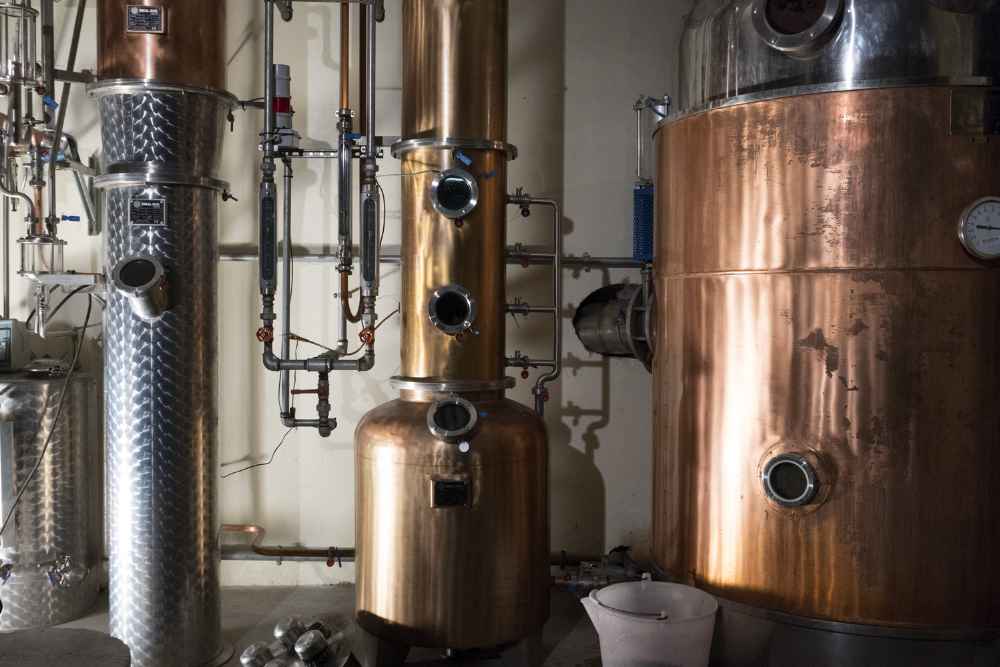This page may contain affiliate links. Please see our Disclaimer for more information. Always drink responsibly and adhere to your local legal drinking age.
Introduction: The Craft Of Distilling The Perfect Vodka
Vodka enchants drinkers around the globe with its crystal-clear appearance and velvety smoothness. But have you ever wondered how this popular spirit goes from simple grains or potatoes to a divine addition to our favorite cocktails? Join us as we venture into the hidden world of vodka-making, unraveling its fascinating history and mastering the fine craft of distilling perfect spirits.
Discover the importance of selecting high-quality ingredients, understanding fermentation techniques, and intriguing insider secrets that transform ordinary spirits into extraordinary elixirs.
Key Takeaways:
- Grain selection, water sourcing and treatment, and yeast strain all play important roles in producing high-quality vodka.
- Enzymes are crucial for converting starches into fermentable sugars during the mashing process, leading to optimal flavor development and alcohol content during fermentation.
- Distillation techniques like pot distillation and continuous distillation yield different results but ultimately aim to separate heads, hearts, and tails in order to balance flavor with alcohol content.
- Filtration methods such as charcoal filtration or reverse osmosis help remove impurities for a smooth mouthfeel in the final product.
The Ingredients Of Vodka
Choosing the right grain, sourcing and treating water, and selecting the perfect yeast strain are crucial steps in producing high-quality vodka.
Grain Selection: Wheat, Rye, And More
Choosing the right grain is essential in vodka production, as it significantly influences the spirit’s overall flavor and character. Wheat, rye, barley, and corn are some of the most popular grains used by distillers in crafting their unique vodkas.
In addition to these classic options, some adventurous distillers even experiment with unconventional grains like quinoa or millet to create truly unique spirits.
The quality of vodka can be elevated by carefully selecting and utilizing various grains during distillation (as seen in our important facts section), which directly impacts its flavor complexity.
Water: Sourcing And Treatment
In the world of vodka production, water plays an essential role in determining the flavor profile and overall quality of the final product. Therefore, selecting the right source and treating it properly is critical for ensuring a premium spirit that cocktail drinkers will appreciate.
Once sourced, water undergoes treatment processes like reverse osmosis or charcoal filtration to remove impurities. That could negatively impact the taste. For instance, Stoli’s vodka uses Russian winter wheat distilled in Riga, Latvia, with carefully treated local waters to achieve its renowned flavor profile.
Treating water helps maintain consistency in both fermentation and dilution stages and ensures compliance with strict industry standards for alcoholic beverages.
Yeast: Choosing The Right Strain
Selecting the ideal yeast strain is a critical step in crafting exceptional vodka, as it significantly determines the spirit’s character and flavor complexity.
Yeast feeds on sugar or starch in the fermentable base, ultimately producing alcohol through fermentation.
For instance, distillers like Adnams use proprietary brewer’s yeast strains acquired in-house to produce their premium vodka, gin, and whiskey.
The Art Of Mashing And Fermentation
During mashing and fermentation, distillers must carefully monitor and control the temperature, pH levels, and enzyme activity to ensure optimal flavor development and alcohol content.
Creating The Mash: Cooked Or Raw?
One important decision in creating high-quality vodka is whether to use cooked or raw ingredients in the mash. Cooked grains can create a more consistent and predictable flavor profile, while raw materials may result in a more complex and unique taste.
For example, raw rye can produce a spicy and bold flavor, while cooked wheat may create a smoother mouthfeel.
Additionally, enzymes play an important role in breaking down starches into fermentable sugars during mashing. Some distillers add commercial enzyme products to ensure consistency, while others rely on natural enzymes in the grain itself.
The Role Of Enzymes In Fermentation
Enzymes play a crucial role in the fermentation process of creating vodka. Before fermentation begins, enzymes are added to break down complex carbohydrates into simple sugars that yeast can use for alcohol production.
One common enzyme used in vodka production is alpha-amylase, which breaks down long starch chains into shorter maltose chains, making it easier for yeast to digest. Another enzyme is glucoamylase, which turns maltose into glucose, providing even more food for the yeast during fermentation.
Distillers must know intimately about enzymes and how they affect different types of grains during distillation if they want to create high-quality vodka with specific flavors and characteristics.
Monitoring And Controlling Fermentation
Fermentation is a crucial stage in vodka production that requires careful monitoring and control to ensure a quality finished product. Here are some key points to consider:
- Temperature: The ideal temperature for most yeast strains used in vodka fermentation is between 70-85°F. Higher temperatures can cause off-flavors while lower temperatures can slow down fermentation.
- pH levels: Proper pH levels (around 4.5-5.5) help to promote healthy yeast growth and prevent contamination by undesirable bacteria.
- Sugar content: Checking for sugar content throughout the fermentation process can help to ensure that the yeast has enough nutrients for healthy growth and alcohol production.
- Oxygen exposure: During fermentation, limiting oxygen exposure is important as this can lead to oxidation and off-flavors in the finished product.
- Time monitoring: Depending on the recipe, fermentation can take a few days to several weeks, so regular monitoring is essential to avoid over or under-fermenting.
By carefully monitoring and controlling the fermentation process, distillers can produce high-quality vodka with consistent flavor profiles and alcohol content.
Distillation Techniques For Perfecting Your Vodka
Distillation is the process of increasing the alcohol content of vodka through heat-induced evaporation and condensation, with two main techniques used: pot distillation, a traditional and labor-intensive method that produces small batches, and continuous distillation, an industrialized technique that yields high quantities.
Pot Distillation: Traditional Method
Pot still distillation is an age-old technique used for centuries to create high-quality spirits, including vodka. This traditional method involves heating a fermented wash in a large copper pot still and then collecting the vapor as it rises through the neck of the still.
The vapor is then condensed back into liquid form, increasing the alcohol content with each pass. Using this time-tested method, distillers can produce a flavorful and complex vodka with distinctive characteristics unique to their distillery.
Continuous Distillation: Modern Technique
Continuous distillation is a modern technique used to perfect vodka, and it is considered more efficient and cost-effective than traditional distillation methods.
This process involves feeding the raw material into the still at one end, continuously heating and vaporizing it, resulting in a higher alcohol content.
The vapors are then condensed into liquid form at the other end of the still, creating a more pure and refined spirit. With this method, distillers can create precise and automated measurements to perfect their alcohol, as iStill technology or Headframe offers custom equipment for continuous craft spirits production.
Heads, Hearts, And Tails: Balancing Flavor And Alcohol Content
During the distillation process, vodka is separated into three parts: “Heads,” “Hearts,” and “Tails.” The “Heads” are characterized by high levels of fusel oil, which can cause headaches.
However, early in the distillation run, they also contain floral and fruity flavors that add complexity to the spirit. As the outflow of the stills from “Heads” to “Hearts,” the desirable middle alcohols are collected.
These make up around 30% of the final product and provide much of its flavor.
Master distillers often judge this moment based on their senses – sight (at which point do different qualities become visible?), smell (when does it start smelling less pleasant?), or even taste (how does it feel on your tongue?).
Filtration Methods For Smooth And Pure Vodka
Charcoal filtration is a traditional and innovative method for producing smooth vodka, while reverse osmosis removes impurities and chill filtration adjusts temperature and texture.
Charcoal Filtration: Tradition And Innovation
The use of Charcoal filtration is a traditional and innovative method used in vodka production to remove impurities and achieve a smooth mouthfeel.
Activated charcoal, which is carbon treated with oxygen to open up millions of tiny pores, is commonly used in this process. The vodka is passed through the activated charcoal, which attracts and removes impurities like minerals, oils, and other chemicals.
This filtration process results in a smoother, purer vodka with a thinner or creamier texture, depending on the producer’s preference for their finished product.
Reverse Osmosis: Removing Impurities
Reverse osmosis is a key filtration method used to produce high-quality vodka. This process removes impurities and ensures smoothness by passing water through a semi-permeable membrane that blocks larger molecules and contaminants.
Top brands like Smirnoff commonly use reverse osmosis to create clean, crisp-tasting spirits. Trade Joe’s Small Batch Vodka, for example, uses reverse osmosis filtration combined with distillation ten times to ensure quality and purity.
Chill Filtration: Temperature And Texture
Chill filtration is a process used by many vodka makers to refine and smooth out the texture of their products. This technique involves cooling the vodka to below-freezing temperatures and then running it through a filtration system that removes unwanted particles, resulting in a cleaner finish.
The temperature of the spirit must be carefully managed during this process, as too low will cause unwanted compounds to freeze onto the filter media. At the same time, too high can lead to incomplete filtration.
Chill filtering can impact the purity and texture of vodka, producing a thinner or thicker mouthfeel, depending on how it’s done.
Aging And Flavoring Your Vodka
To infuse character and complexity into vodka, it can be aged in oak barrels or flavored with natural or artificial ingredients at specific timing and temperature, balancing flavor and consistency.
Oak Barrel Aging: Infusing Character And Complexity
Oak barrel aging is a popular method used by distillers to add character and complexity to their vodka. The process involves storing the spirit in oak barrels for a few months to several years, allowing it to absorb flavors such as vanilla and caramel from the wood.
Many master distillers swear by barrel aging as an important part of creating high-quality vodka. For example, some brands choose only virgin American Oak barrels because of their distinct flavor profile.
Over time, these barrels can develop unique characteristics that give vodka its signature taste and aroma.
Infusing Flavors: Natural And Artificial Methods
To add flavor to vodka, distillers often use natural or artificial infusion methods. Some popular natural ingredients include fruits, herbs, and spices.
For example, a raspberry-infused vodka might be made by steeping fresh raspberries in the finished spirit for several days before filtering out the solids.
Artificial flavorings can also be used to create unique and exciting flavors in vodka. These can range from simple extracts like vanilla or almond to more complex blends that mimic the taste of other spirits, such as whiskey or tequila.
While some purists may turn their noses up at artificially flavored vodkas, they have become increasingly popular among cocktail enthusiasts looking for new ways to mix up classic recipes.
Timing And Temperature: Balancing Flavor And Consistency
One of the most important aspects of creating a perfect vodka is getting the timing and temperature right during the distillation process. Timing refers to how long the mash is fermented and when it’s distilled, while temperature directly affects how flavors develop in your vodka.
For example, if you distill at a lower temperature, you may have a smoother flavor profile but less alcohol content.
It’s also worth noting that aging can have a significant impact on both flavor and consistency. Oak barrel aging imparts complex vanilla and toasted nut flavors to your spirit while mellowing out any harsh edges in its taste.
By contrast, infusing natural or artificial flavors into your vodka requires precision timing to extract maximum potency from ingredients like pineapple or cucumber without overpowering them completely.
The Science Of Vodka Production
Chemical reactions play a major role in vodka production, with ethanol and other compounds transforming the distillation process.
Chemical Reactions: Ethanol And Other Compounds
Vodka production involves a series of chemical reactions that produce ethanol and other compounds. Ethanol is the key component of vodka, but it’s not the only one.
During distillation, various aldehydes, esters, and primary alcohols like methanol and isoamyl alcohol are also produced.
For example, methanol is toxic in large quantities but is naturally present in small amounts during fermentation. Vodka makers take great care to remove excess methanol through careful distillation processes to ensure their products meet safety standards.
Understanding the science behind vodka production helps us appreciate this spirit even more deeply.
Temperature And Pressure: Controlling Distillation
Controlling temperature and pressure is key to the distillation process of making vodka. Distillers use heat to vaporize the liquid, which separates the alcohol from impurities.
This process can be controlled by adjusting temperature and pressure levels to produce a high-quality spirit with consistent flavor and alcohol content. For example, if too much heat is applied, it can result in unwanted flavors or aromas in the final product.
By carefully monitoring these factors, master distillers can create a clean and smooth vodka that perfectly balances ethanol content with taste.
PH Levels: Testing And Adjusting
Before bottling, vodka producers test the pH levels of their product to ensure its consistency and quality. The pH can impact the flavor profile, with more acidic vodkas having a sharper taste than those with a higher pH.
Testing and adjusting the pH is an important step in crafting premium vodka.
It’s worth noting that water plays a significant role in determining the final pH of vodka. Different sources and treatments can influence mineral content and acidity levels, affecting the overall taste and mouthfeel of the product.
Crafting Premium Vodka: Tips From Master Distillers
Master distillers emphasize the importance of using high-end ingredients, experimenting with new techniques, and innovating by making small batches of vodka to ensure quality over quantity.
Small Batch Production: Quality Over Quantity
Small batch production is a trend that has recently gained popularity among vodka producers. Instead of creating large quantities of spirits, small-batch distilleries focus on creating high-quality vodka.
One example of a successful small-batch distillery is Tuthilltown Spirits in New York. They carefully select the best grains for their vodka and use traditional copper pot stills to create a smooth, premium product.
They have achieved critical acclaim by prioritizing quality over quantity and won numerous awards for their handmade spirits.
High-End Ingredients: Organic And Local Sourcing
For those looking for a truly premium vodka experience, choosing a brand that sources high-end, organic ingredients can make all the difference. Organic grains and herbs ensure that the final product is not only of superior quality but also free from harmful pesticides or chemicals.
For example, Hali’imaile Distilling Company in Maui uses locally sourced ingredients like sugarcane and pineapple to create their award-winning spirits. Meanwhile, Disobedient Spirits in Kansas prides itself on its farm-to-glass approach, utilizing homegrown wheat, rye, and corn in its small-batch whiskey and gin production.
Innovation And Experimentation: Pushing The Boundaries
Innovation and experimentation are key elements in creating new and exciting vodkas. Many distilleries worldwide are now pushing the boundaries of traditional techniques to produce distinctive flavors, textures, and aromas that cater to a wide range of tastes.
Others experiment with aging techniques by using barrels made from different types of wood or even non-traditional materials like ceramic or glass.
These innovations have led to an explosion in flavored vodkas that cater to diverse palates and preferences. From fruit-infused varieties to spicy blends, there is no shortage of creativity when crafting premium vodka today.
The History And Evolution Of Vodka
Vodka has its roots in Russia and Poland, originally made as a low-quality, high-alcohol spirit to combat the harsh weather.
Origin And Spread: Russia, Poland, And Beyond
Vodka has a rich history can be traced back to Russia and Poland, where it was first produced in the 8th and 9th centuries. Russians often claim they originated vodka, while others believe it originated in Poland.
In both countries, vodka was used for medicinal purposes before becoming a popular alcoholic beverage. The word “vodka” comes from the Russian translation of “water,” while Polish called all-white distilled drinks by this name.
Today, vodka is enjoyed worldwide and produced in many different countries using various ingredients and methods.
Popular Brands And Variations: Flavored, Infused, And More
Vodka has taken on many different variations and flavors throughout its history. Here are some popular brands and types that cocktail drinkers should know:
- Flavored Vodkas: These are vodkas infused with fruits, herbs, spices, and other natural flavors. Examples include Absolut Citron (lemon flavor), Skyy Infusions Pineapple (tropical flavor), and Grey Goose L’Orange (orange flavor).
- Infused Vodkas: These are vodkas infused with ingredients like hot peppers, cucumber slices, or vanilla beans for a unique taste.
- Organic Vodkas: These vodkas are made from organic grains and distilled in an environmentally-friendly manner that emphasizes sustainability.
- Craft Vodkas: These vodkas come from small-batch distilleries emphasizing quality over quantity. They often use locally-sourced ingredients to create unique and flavorful spirits.
- Premium Vodkas: These high-end vodkas often feature unique packaging and marketing tactics to appeal to discerning consumers who are willing to pay a premium price for top-quality vodka.
No matter your preference, there is vodka for every cocktail drinker’s taste. The possibilities for enjoying vodka in cocktails are endless, from classic brands to modern twists on this timeless spirit.
Vodka In Culture: Art, Literature, And Film
Vodka has made its way into popular culture in various ways. It has become a staple in many films and TV shows, from iconic James Bond martinis to “The Dude’s” White Russians in the cult classic The Big Lebowski.
In literature, vodka is often depicted as a symbol of power or an escape from reality. A prime example of this is Fyodor Dostoevsky’s Crime and Punishment, where protagonist Raskolnikov is seen drinking copious amounts of vodka after committing murder.
Vodka has also inspired artists throughout history, with Andy Warhol even creating paintings featuring Absolut Vodka bottles.
FAQ
Q: What is vodka?
A: Vodka is a distilled alcoholic beverage typically made from fermented grains or potatoes. It is a clear liquid with a neutral flavor and a high alcohol content. It is often enjoyed neat or in mixed drinks.
Q: How is vodka made?
A: Vodka is made by a process called distillation. First, the ingredients used to make vodka, usually grains or potatoes, are fermented with yeast to produce alcohol. The resulting liquid is then distilled to remove impurities and increase the alcohol content. This process is typically repeated several times until the desired alcohol by volume (ABV) is achieved. The vodka is then diluted with water to create the desired proof before being bottled.
Q: What are the main ingredients used to make vodka?
A: Vodka is typically made from fermented grains such as wheat, rye, or barley. However, it can also be made from other starchy foodstuffs containing sugar, such as potatoes, sorghum, or grapes.
Q: What is the production process for vodka?
A: The production process for vodka involves several steps. First, the main ingredient, such as grains or potatoes, is milled and mashed to create a slurry. The slurry is then mixed with water and yeast to ferment. After fermentation, the resulting liquid is distilled to remove impurities and increase the alcohol content. The vodka is diluted with water to achieve the desired proof and bottled.
Q: What is the difference between vodka brands?
A: The difference between vodka brands can be the ingredients used, the production process, and the country of origin. Some vodka brands are made from different grains or potatoes or may use a unique filtration process to produce a distinct flavor. The vodka belts countries, such as Russia and Poland, are well-known for their vodka production, and many popular brands come from these regions.
Q: Can vodka be made using something other than grain?
A: Yes, vodka can be made using other starchy foodstuffs that contain sugar, such as potatoes, sorghum, or grapes.
Q: What is a column still, and how is it used in vodka production?
A: A column is still used in vodka production to distill the alcohol to high purity. It consists of a tall column with several levels of trays or plates, which allows the alcohol vapor to rise and come into contact with more surfaces. This process helps to remove impurities and create a neutral flavor for the vodka.
Q: What is the proof of vodka?
A: The proof of vodka refers to its alcohol content. In the United States, vodka is typically bottled at 80 proof, 40% alcohol by volume (ABV). However, depending on the desired strength, vodka can be bottled at a higher or lower proof.
Q: Can vodka be used in cocktails?
A: Vodka is a common ingredient in many mixed drinks and cocktails. It has a neutral flavor and high alcohol content that makes it a versatile spirit for mixing with other ingredients.
Q: What are rectified spirits, and how does it relate to vodka?
A: Rectified spirits are a type of ethanol purified through repeated distillation. Vodka is often made from rectified spirits distilled to a very high purity to create a neutral flavor.
Q: How is an American vodka brand different from other vodka brands?
A: American vodka brands may use different ingredients, production processes, and filtration methods than vodka brands from other countries. Some American vodka brands use malted barley to create a unique flavor profile, while others may use different water sources. However, like other vodka brands, American vodkas are typically distilled to high purity and have a neutral flavor.
Conclusion: The Art And Science Of Distilling The Perfect Vodka
In conclusion, crafting the perfect vodka is a delicate balance of art and science. From selecting the right ingredients to mastering fermentation and distillation techniques, creating high-quality vodka requires skill, patience, and attention to detail.
Whether you prefer classic vodka or flavored variations, understanding the history and evolution of this popular spirit can enhance your appreciation for the craft. So next time you sip on your favorite vodka cocktail, take a moment to appreciate all that goes into producing that smooth, pure spirit.





















